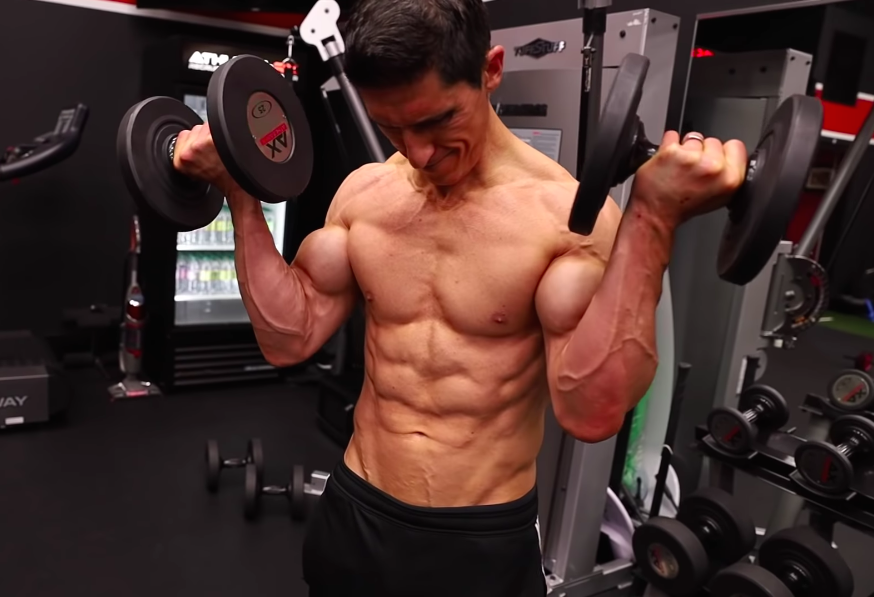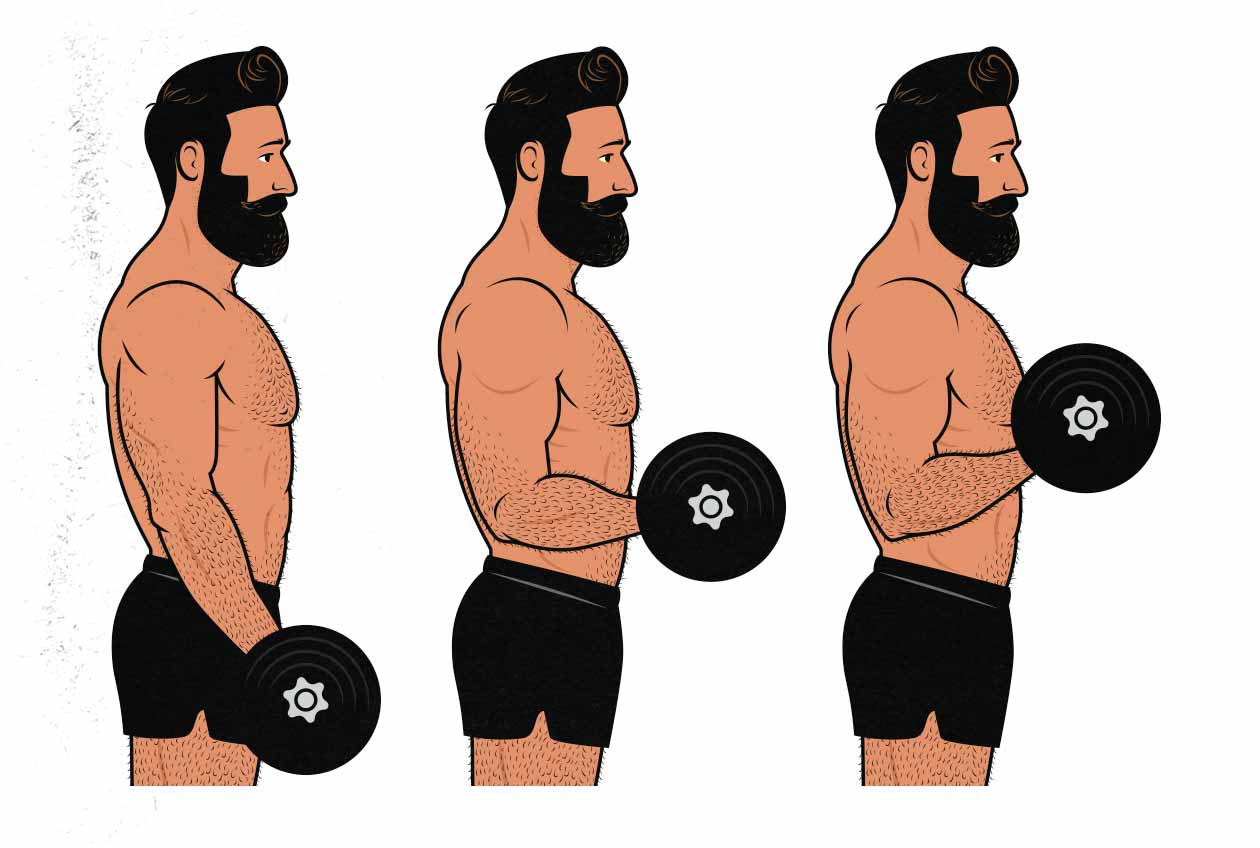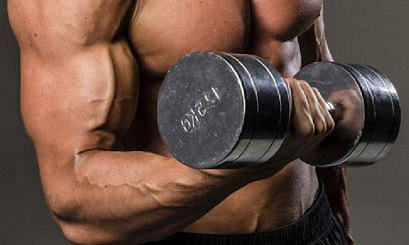
The basic biceps flexion with dumbbells is an isolating and naturally pulling exercise for biceps. The movement offers conditions for various performances, according to the functional or visual goals of the trainees. Suitable for all trainees.
The arms are folded at the elbow joints, and movement in the shoulders and shoulder girdle is limited. The wrists can be movable or immovable according to the accent. In isolated variants, the movement takes place only in the elbows, while the other joints remain immobile. You can do the exercise with one or two hands, with different body positions, multiple grips and hand positions.
Contraindications
In case of injuries to the shoulders, shoulder girdle, elbows or wrists, perform with light weight and caution. If you have low back problems, use a backrest option.
Participating muscles
Dynamists
- Biceps (Biceps brachii)
Synergists
- Brachialis
- Brachioradialis
Extras and dynamic stabilizers
- Shoulder muscles, front heads (Deltoid, Anterior)
- Wrist flexors
- Trapezius muscles, upper and middle part (Trapezius upper and middle)
- Shoulder lifters (Levator scapulae)
- Rectus abdominis
- Oblique abdominal muscles (Obeliques) – in unilateral performance
- Long spinal muscle (Erector spinae)
- Large gluteal muscles (Gluteus maximus) – when standing upright
- Quadriceps – when standing upright and when sitting without support in the back
- Calves (Gastrocnemius) – when standing upright
- Large pectoral muscles (Pectoralis major)
 Options according to body position
Options according to body position
- Standing folding – a classic power option, allows the use of cheating and all possible accents in the grip and consistency. Engages the largest number of stabilizing muscles during performance.
- Folding from a seat – reduces the need to stabilize the body from the waist down. Leaves limited cheating options. Allows all types of folding except transverse.
- Folding from a seat (with a fixed back) – removes the load from the stabilizers in the torso. Combining with a cheating approach is not recommended.
- Others – more specific positions are possible, such as folding from an inclined seat, from an inclined front bed, etc. We will consider them in detail in specialized articles.
Options according to the type and width of the grip and accents
Static grips
- Neutral (parallel) grip – the outer heads dominate, the participation of brachialists and brachioradialis is significant.
- Semi-supinated (the levers point slightly diagonally outwards) – reduces the role of synergists, distributes the load evenly between the two heads.
- Supinated (palms point in one direction) – the emphasis is on the inner heads.
* The pronated grip is not included, because during pronation (palm to the floor) the forearms and brachialis take too much load and get tired quickly. This does not allow effective insulation of the biceps outer heads due to the lowered threshold in the working weight.
Dynamic grips
- Neutral to semi-supine – the two heads together give starting power. The outer heads are in a better position at the lower point and the inner ones at the upper point. This dynamic grip allows the highest degree of efficiency of all listed below. Power grip.
- Neutral to supinated – requires slower execution. Predisposes to higher tone. Great choice in series for strength endurance and endurance.
- Neutral to semi-permeated – accentuating the outer heads grip.
- Semi-supinated to supinated – accentuating the inner heads grip.
According to the accent, ie. according to the position of the elbows-wrists
- No effect on accent – parallel and fixed to the body wrists and elbows. The position of the palm, ie. the grip may affect with a slight accent, although the joint position does not predispose this. A basic position that predisposes to folding strength and efficiency.
- Inner heads – wrists beyond the elbows, all joints are fixed. This open position predisposes the inner biceps to take most of the load because it puts the outer ones at a disadvantage. The supine grip would complete the insulation.
- External heads – wrists inward from the elbows, all joints are fixed. This position is closed and does not allow the inner biceps heads to realize their potential. Thus the outer heads dominate the flexion. A parallel grip would complete the insulation.
Variants according to the sequence
- One-sided – a series with one hand, then a series with the other. Allows better concentration on the accent. Advanced technique.
- Bilateral simultaneously – simultaneous folding with both hands. Allows lifting more weight. Power equipment.
- Bilateral sequentially – alternating repetition with one hand and then repetition with the other hand. Allows lifting more weight within the series. Delays the onset of fatigue. Appropriate technique for voluminous endurance training, as well as for beginners, as it does not divide the attention.
Simultaneous biceps flexion from a standing position with a neutral grip and without accents.
Execution
- Take the dumbbells and take a starting position with your arms vertically relaxed.
- Fix shoulders, elbows. Tighten the torso muscles.
- Slowly bend your arms without moving your elbows apart, keeping your armpits upright.
- After fully folding your arms, slowly return to the starting position.
- Repeat until the end of the series.
Recommendations
- Do not move your elbows unless you want to help your shoulders.
- Do not twist your spine or twist your body while lifting.
Dumbbell bending is an exercise that can increase muscle mass in the biceps, focus on individual heads and improve the stabilization of your shoulder girdle.
For fitness and bodybuilding split workouts, you can do it at the beginning of a biceps workout as a first or second exercise. The location of the biceps flexion with dumbbells strongly depends on the way it is performed, ie. whether you perform it short, heavy and forceful, or are looking for long pumping series. The presence or absence of accents in movement and grip are also important.


